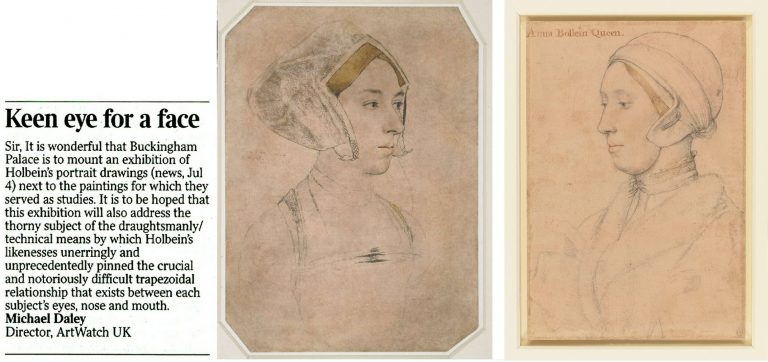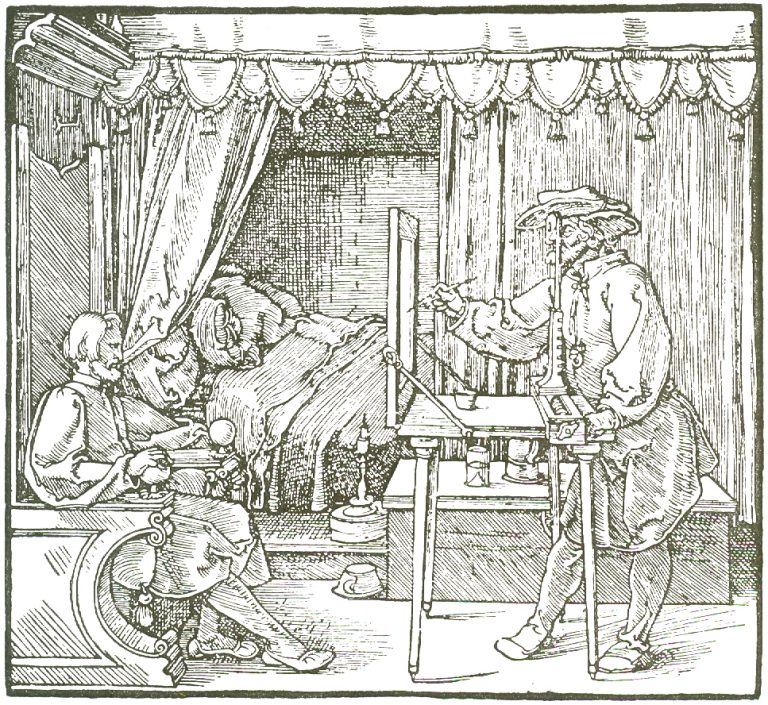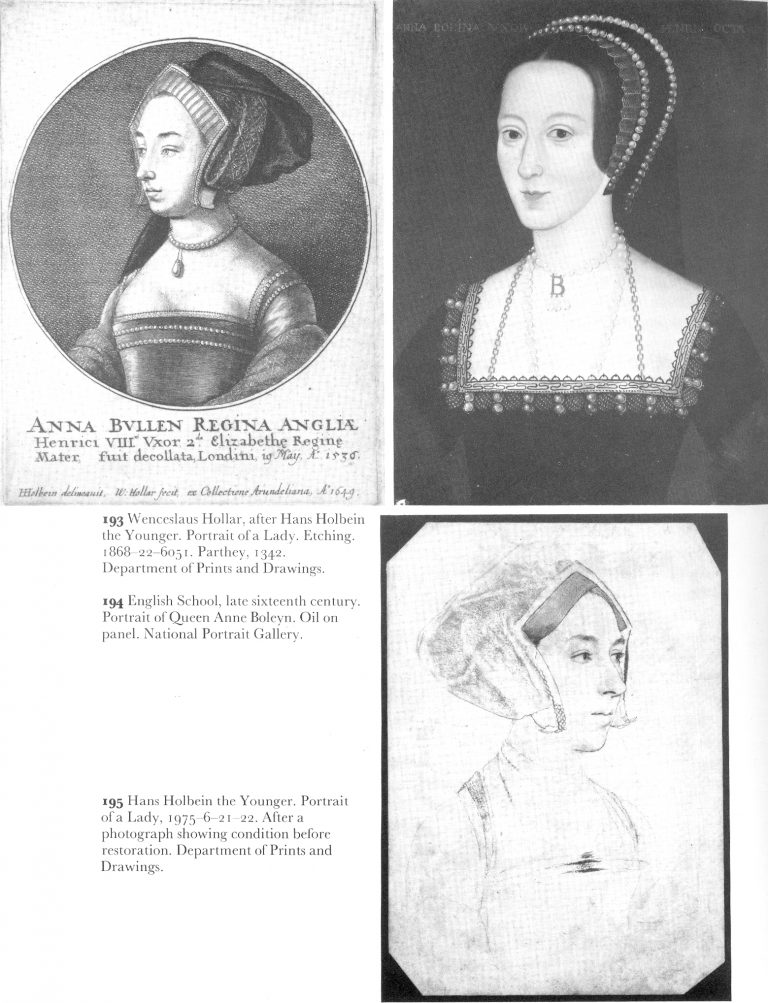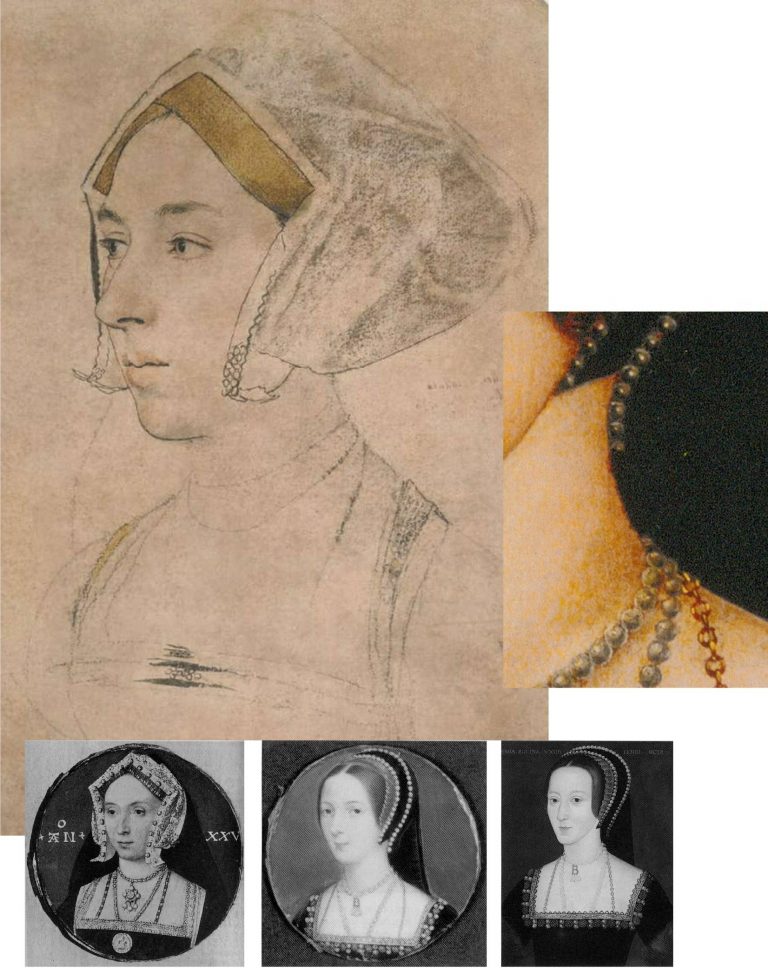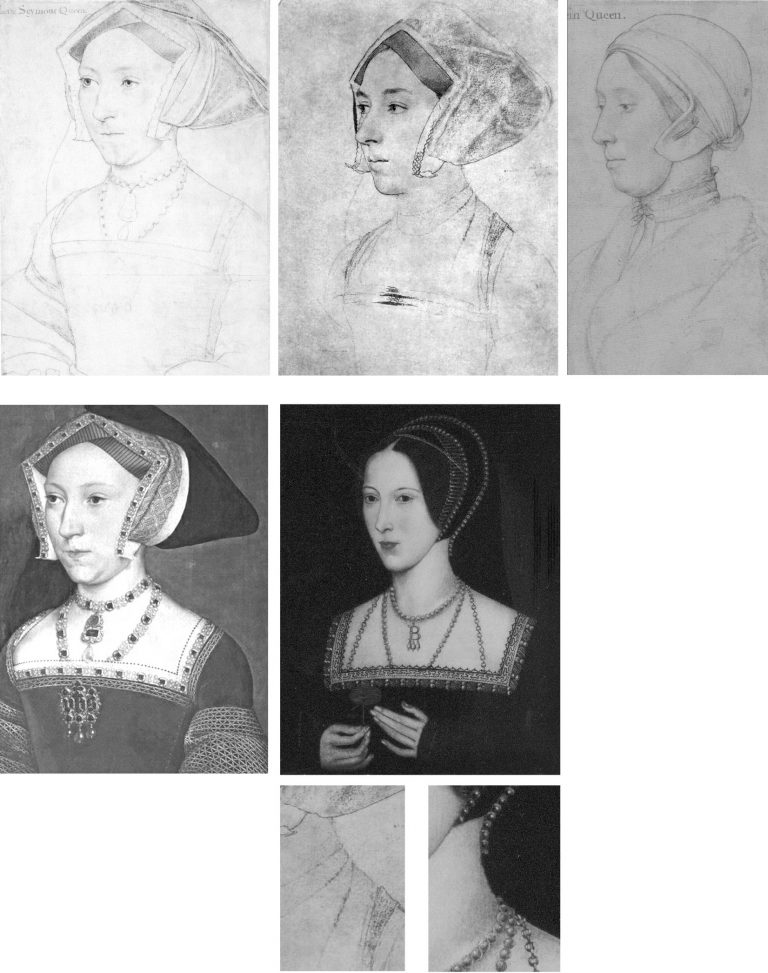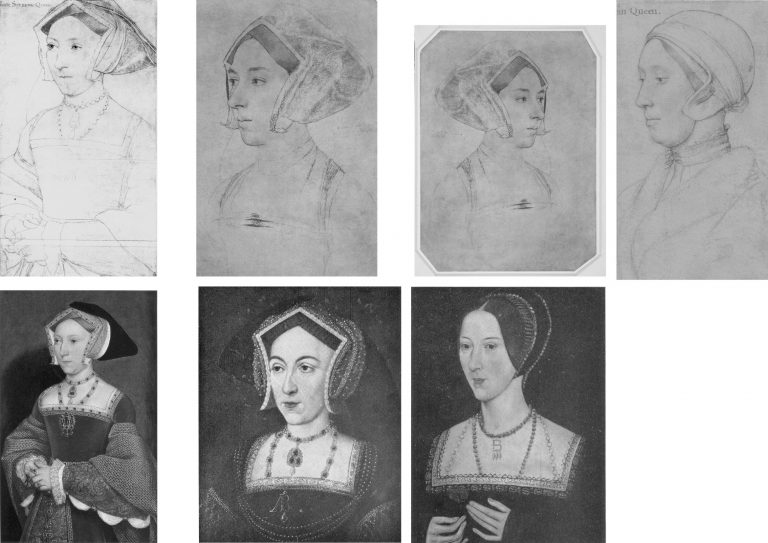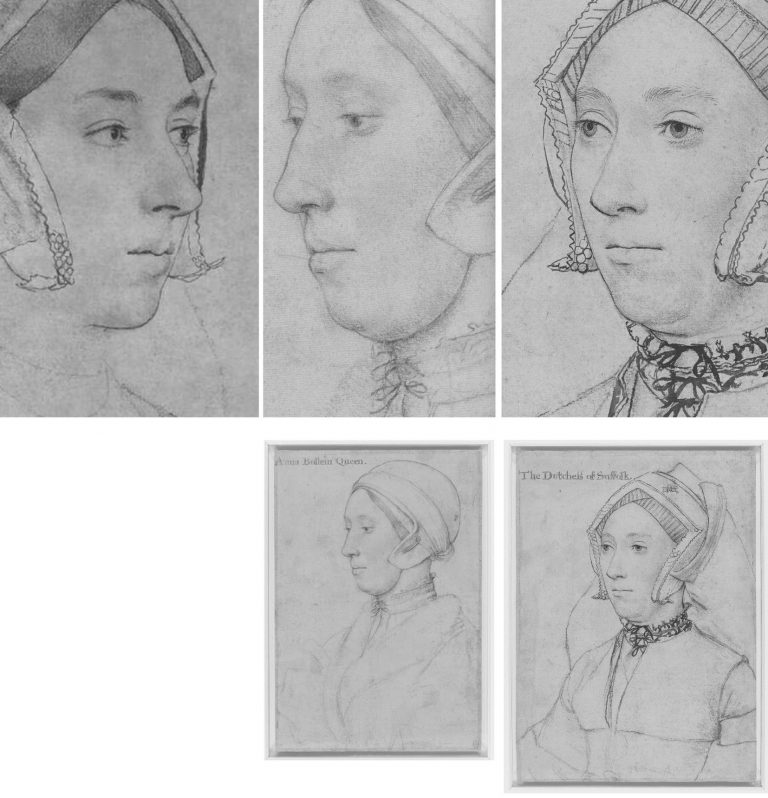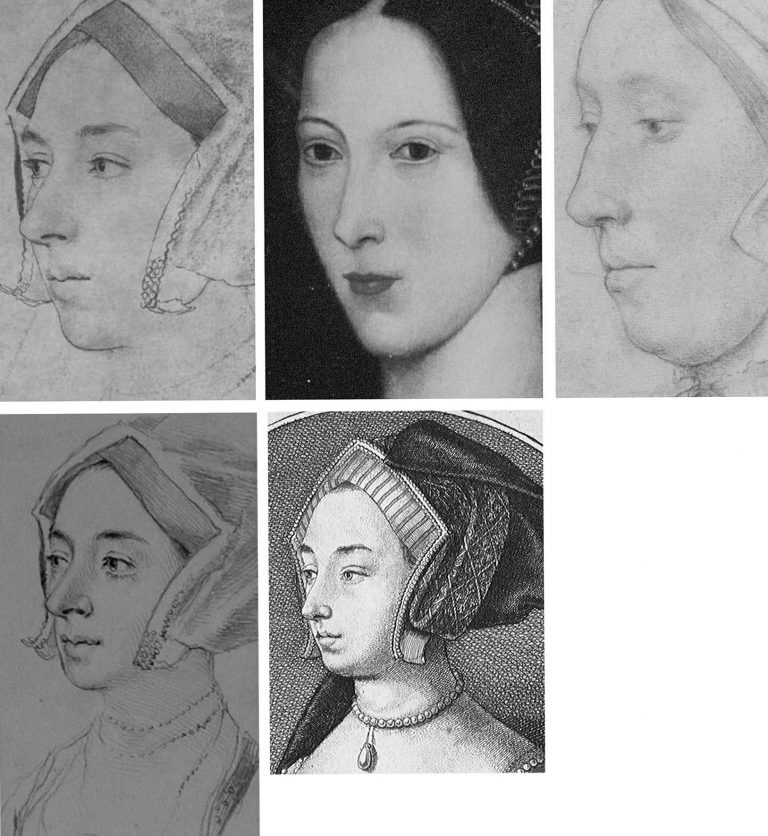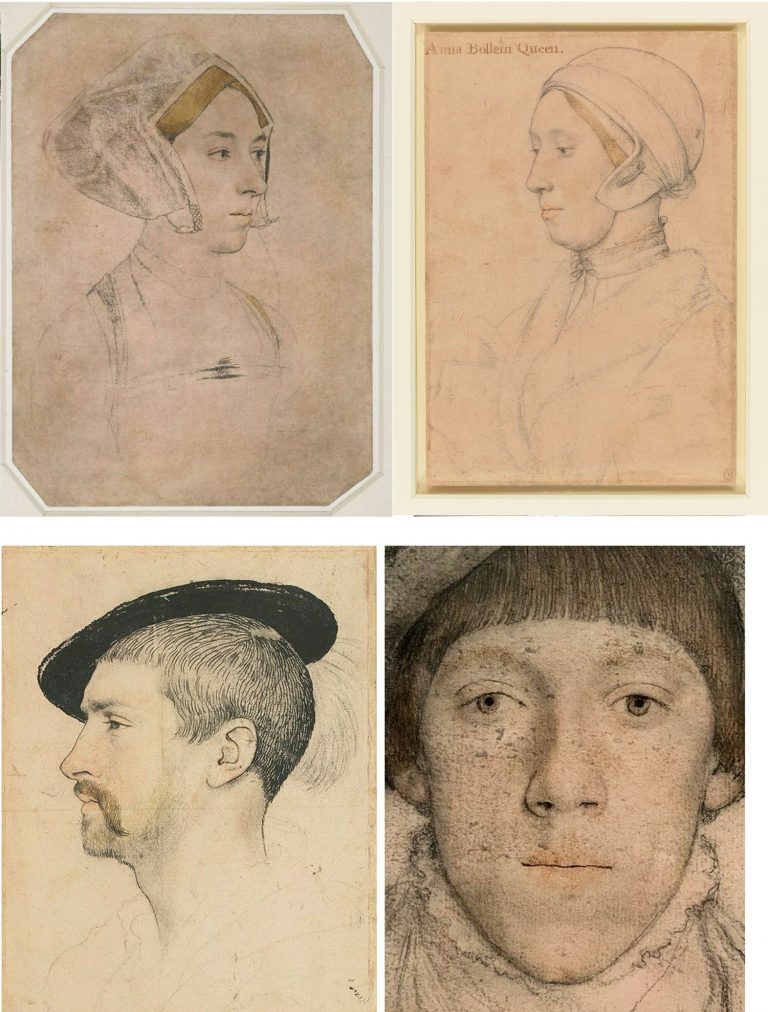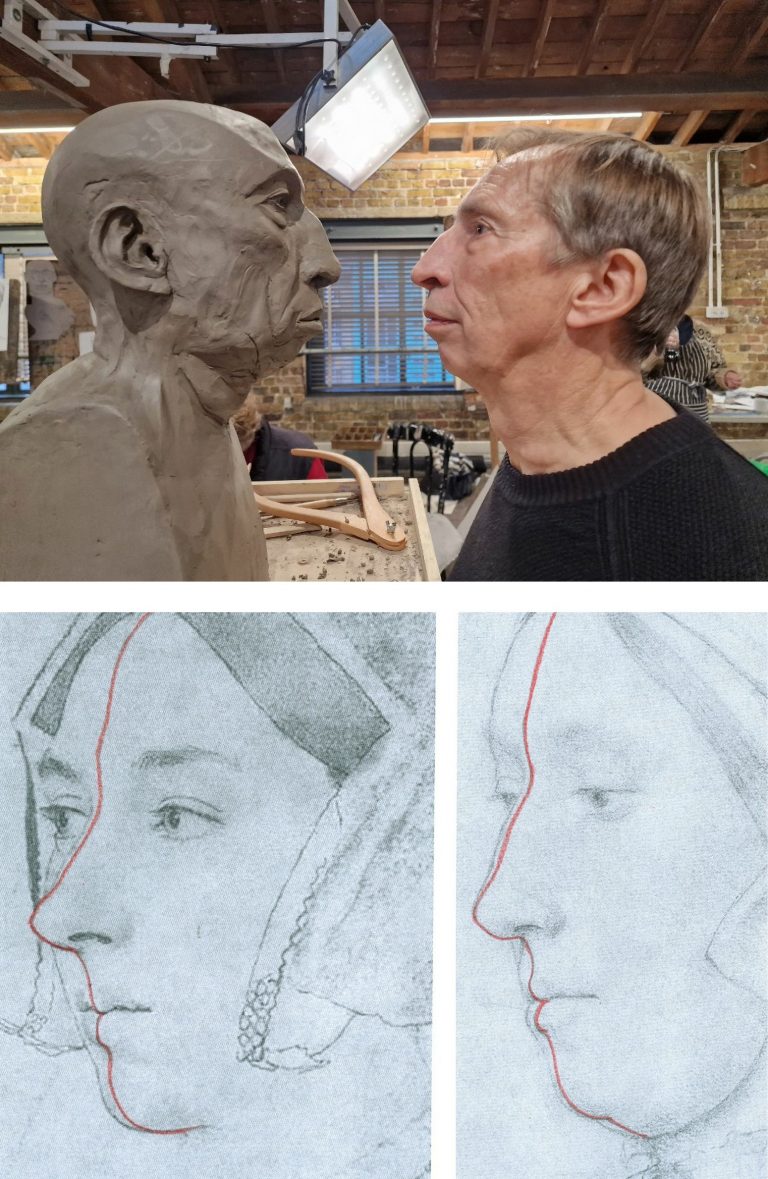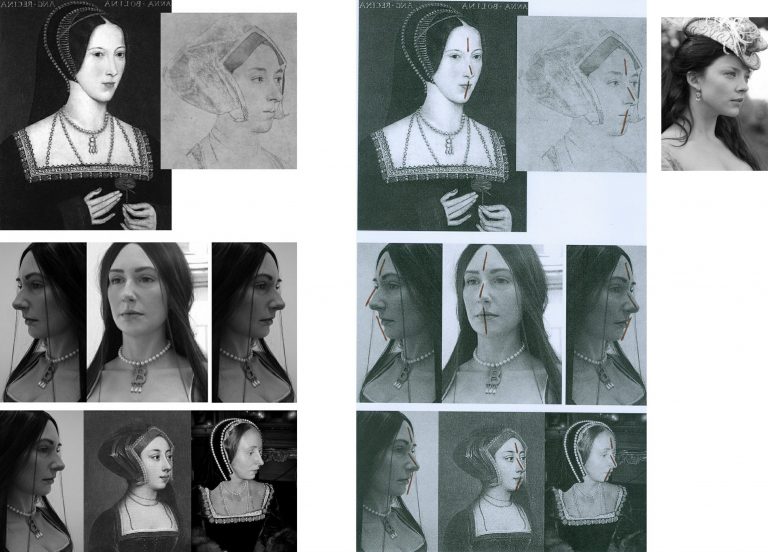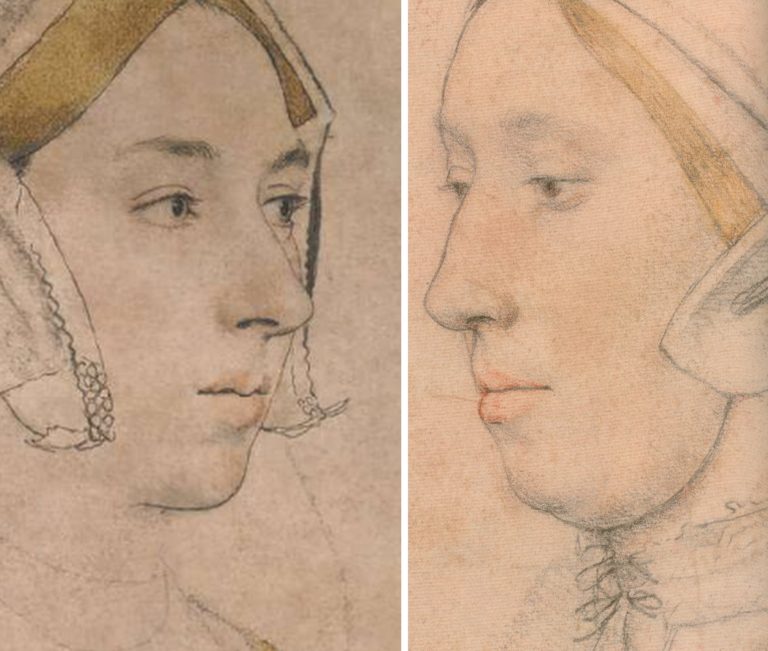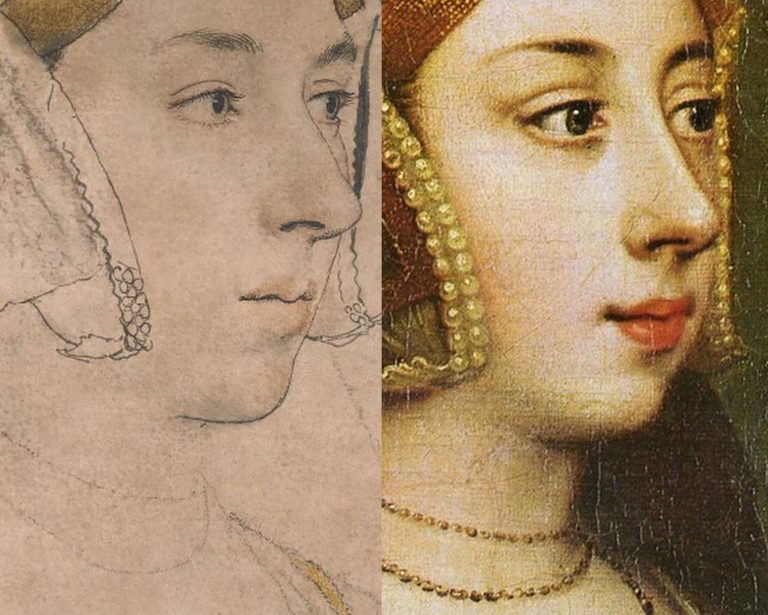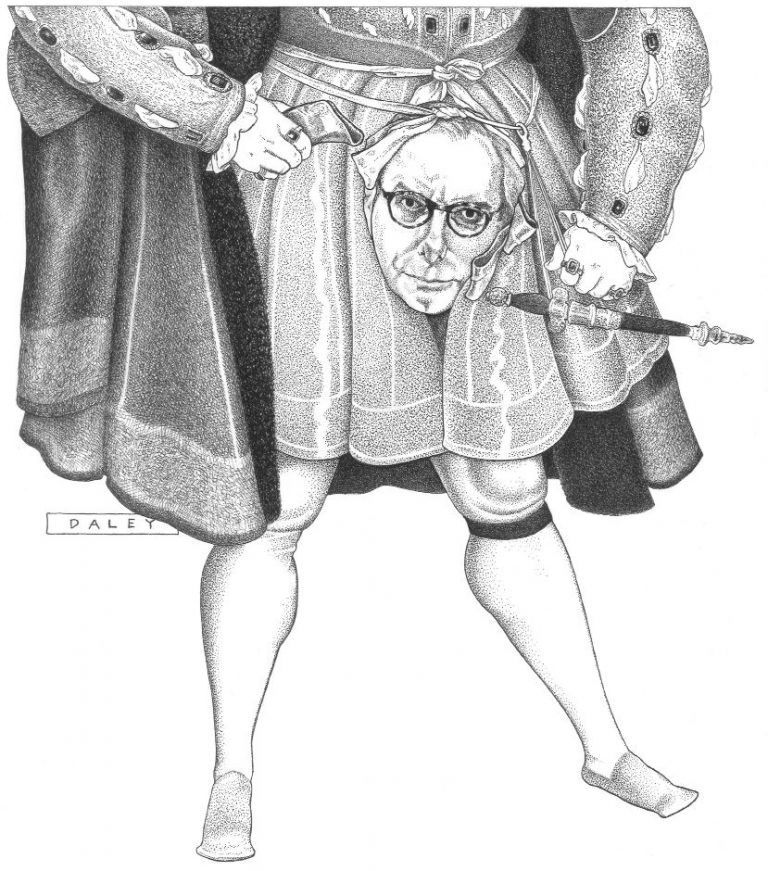Art can suffer many injuries and indignities. The worst of these, short of outright destruction – but also irreversible – is restoration damage. Misattributions corrupt and debilitate oeuvres and can mask restoration injuries – but they can be corrected. In portraiture depicted sitters can be misidentified but, again, these can be corrected. When presented to the world, injurious restorations, misattributions and misidentifications alike are commonly trumpeted as “discoveries”. Such discoveries, as in the misidentification examined here, can be claimed without supporting evidence or, even, against strong contra-evidence.
ANNE BOLEYN’S NEW HEAD
On 14 March 2007 the Daily Mail (“Finally historians can give Anne Boleyn her head back”) reported:
“A Holbein drawing has been revealed as the only portrait of Henry VIII’s second wife Anne Boleyn. The c.1530 picture carries Anne’s name but other evidence suggested this was an error. Now expert Bendor Grosvenor and historian David Starkey have traced the inscription to her contemporary Sir John Cheke, confirming she is indeed the subject.”
Four years later the claimed confirmation of the Royal Collection’s “Anne Boleyn” drawing graduated into “certainty” on Bendor Grosvenor’s 15 December 2011 Art History News post “Anne Boleyn regains her head”:
“This isn’t ‘news’ as such, but in a foray into the Tudor realms of Twitter last night I mentioned the drawing of Anne Boleyn by Holbein in the Royal Collection. I said that although in the past the identity was doubted by art historians, the sitter was now catalogued with certainty as ‘Anne Boleyn’, as you can see on the Royal Collection website…”
THE TRUE ANNE BOLEYN LIKENESS
Since 1977, the dispute over Anne Boleyn’s likeness has turned on two Holbein portrait drawings of equal artistic merit and provenance strength but of manifestly different sitters. One drawing is in the British Museum, the other is in the Royal Library at Windsor (see Fig. 1 below). While the Windsor drawing’s advocates claim “certainty” on their “Anne Boleyn” identification, both drawings bear written Anne Boleyn ascriptions derived from the same largely reliable historical source and the British Museum drawing had been considered the true likeness for many centuries. How, then, had the switch occurred? The now protracted Anne Boleyn Identity Literature discloses the Royal Collection’s acceptance of a campaign which had eschewed all use of the most illuminating art critical tool – the photo-comparison. In this switch of identities, Art had been denied its own voice as words trumped the intrinsic – and markedly contrary – visual testimony of images.
EYES, NOSES and MOUTHS: GIVING A VOICE TO HOLBEIN
In a letter to the Times (5 July 2023) we had hoped a forthcoming Holbein portrait drawings exhibition might address the drawn method by which Holbein unerringly fixed the characteristic trapezoidal relationships between a sitter’s eyes, nose, and mouth.
Above, Fig. 1: Left, ArtWatch UK letter; centre, the British Museum Holbein drawing formerly said to depict Anne Boleyn; right, the Royal Collection Holbein drawing now said to depict Anne Boleyn.
The British Museum Anne Boleyn drawing was not in the Buckingham Palace exhibition Holbein at the Tudor Court and therefore was not discussed. The Royal Collection Trust’s Senior Curator of Prints and Drawings, Kate Heard, speaks in the catalogue of Holbein’s “sensitive and life-like” depictions that “bring us face to face” with key Tudor players. The portraits are addressed in terms of social history and patterns of patronage, as in Holbein’s rise from foreign itinerant to court artist, and with Heard wondering whether, as the only artist of his day to possess a horse, Holbein travelled to his sitters, or they to him. His drawing method was discussed as “taking likenesses” and on the frequency with which his chalk drawings had been reinforced with ink in possible preparation for transfer as “patterns” for painted portraits.
Heard’s “taking likenesses” was a telling phrase because distinctions are commonly drawn between making drawings and taking photographs and because Holbein’s depicted facial features can seem as reliably fixed as in any photograph.
Above, Fig. 2: Durer’s depiction of a method of capturing traced outlines and features on a pane of glass.
The scholar who had held the formerly Bradford family, now British Museum, Holbein portrait of Anne Boleyn to be the true likeness (Fig. 1, above, centre) was K. T. Parker in his seminal 1945 book The Drawings of Hans Holbein in the Collection of His Majesty the King at Windsor Castle. Parker succeeded Kenneth Clark as Keeper of the Department of Fine Art in the Ashmolean Museum, Oxford, and was Keeper of the whole museum from 1945 until his retirement in 1962. His high reputation as a connoisseur is said to have been laid when working in the British Museum’s Department of Prints and Drawings with A. E. Popham and Campbell Dodgson.
THE RELIABILITY OF INSCRIPTIONS
In Parker’s book, the Windsor Royal Library drawing’s inscribed identification as “Anna Bollein Queen” (Fig. 1, above, right) was bluntly dispatched:
“The inscription is certainly incorrect, the features showing no resemblance whatever with the well authenticated drawing of Anne Boleyn in Lord Bradford’s possession”.
Parker drew a distinction between “two kinds” of evidence – “pictorial” and “literary” (or visual and documentary) and was duly alert to the importance of both. As will be examined separately, he also advanced a pictorially sophisticated hypothesis that Holbein, like Durer at Fig. 2 above, might have fixed the essential features of his sitters by tracing them onto a pane of glass and transferring the resulting image to paper. Here, we consider how and why visual records failed to receive due critical consideration when the Anne Boleyn sitters’ identities were switched.
A REVISIONIST CHALLENGE
In 1977 John Rowlands, the then deputy keeper of prints and drawings at the British Museum (and, later, Keeper from 1981 to 1991), challenged the Anne Boleyn identification in the Parker-endorsed drawing. The “demotion” was curiously, if not inappropriately executed. First, it was made not in a scholarly journal – which could have facilitated a correspondence – but in the museum’s own YEARBOOK No. 2 (“A portrait drawing by Hans Holbein the Younger”). Second, it was not advanced on its own merits but was slipped within a commemorative article on the British Museum’s recent acquisition from the Bradford family of its landmark Holbein drawn portrait. The article itself carried just three photographs (as shown below) and with none of the Royal Library drawing being espoused as the new, true Anne Boleyn likeness.
Above, Fig. 3: The three illustrations to Rowlands’ British Museum Year-Book II article. There was also a full colour plate of the newly acquired drawing.
Rowlands acknowledged the new acquisition as an outstanding drawing that had traditionally been held to be of Queen Anne Boleyn (Paul Ganz,1937; Karl Parker 1945). He offered no artistic grounds for his “de-identification” of the drawing’s sitter – indeed, as shown below, he celebrated the drawing’s supreme artistry – and he made no suggestion of another likely or possible sitter. The relative visual authority/plausibility of the two radically different depictions of the same historical figure was not examined. Rowlands’ sole objection to the British Museum’s own drawing was documentary – that its Anne Boleyn ascription could be traced no further back than 1649 when in the Earl of Arundel’s collection and where it was copied in Wenceslaus Hollar’s etching (Fig. 3 above, top left).
The objection seemed something of a pedantic contrivance: both the etching and the drawing bore an inscription which identified the sitter as Anne Boleyn and gave the date of her beheading – “Anna Bullen decollata fuit Londini 19 May 1536”. On the general authority of the inscriptions on Holbein’s drawings, Parker had reported that of the eighty-five Royal Collection Holbein drawings sixty-nine bore written inscriptions from an inventory made in 1590 to which the names of the identified sitters had been “subscribed” by “Sir John Cheke, Secretary to King Edward the 6th”. Cheke had died in 1557. The British Museum’s new drawing had been part of the Royal Collection’s Holbein holdings after the artist’s sudden death in 1543 from the plague. Most inscriptions on Holbein’s portraits thus originate from the turn of the sixteenth and seventeenth centuries. Parker held that because Cheke had had direct contact with many of the drawings’ sitters, his subscribed names enjoyed “abundant claim to interest and attention, though not, of course, to blind faith.” The eventual acceptance of Rowlands’ misidentification by the Royal Collection evidently rested on a claimed near-infallibility of Cheke’s recorded identifications – even though he had evidently given the same sitter to two incompatible drawn portraits.
IN AND OUT OF HISTORY
Rowlands, who would later be supported by two historians (David Starkey and Bendor Grosvenor) and opposed by a third (Eric Ives, author of an acclaimed Anne Boleyn biography), acknowledged “a strong likelihood” that the Bradford/BM drawing had been incorporated in the famous “Great Booke” of bound Holbein drawings and had subsequently been removed from it:
“How and when the ‘Anne Boleyn’ sheet became separated from the rest is unknown, but this probably occurred after the death of the earl of Arundel in 1646”.
Rowlands also held that although the British Museum drawing had been incorporated within the famous book, such incorporation was no guarantor of pedigree: the Windsor group “undoubtedly contains drawings which are not by Holbein”. Such a consideration would, of course, apply to all works bound in the book. Parker had said in 1945 that: “The Windsor series certainly contains extraneous matter, but the only drawing known to be incorporated at a later date is the so-called ‘Amelia of Cleves’…in the eighteenth century”. Rowlands spoke too of “extractions” from the book, with the first having probably begun “around 1630″. With the British Museum drawing, he said its date of extraction was unknown but had “probably occurred after the death of the Earl of Arundel in 1646” and “probably in the reign of Charles II [1660-1685]”.
A CLASH OF DATES AND AN ARISTOCRATIC VILLAIN
Against his own “probablys”, Rowlands cited and accepted a detailed account of how the now British Museum drawing had been stolen by the Bradford family when the great book was owned by Jonathan Richardson, senior. Rowlands quoted Richardson’s son’s account of the theft in full:
“The Original of this Drawing, by Holbein, of his finest style & most Capital, the Old E[arl] of Bradford cheated my father of Thus. When he was confined with gout, a little before his Death, He sent request to my F[ather] that he would lend him a Book of Drawings to Divert him; w[hi]ch my F[ather] compl’d with. The E[arl] sent him back the Book in a few Days, but without this Drawing. My F[ather] went immediately to wait on him, & found the Drawing hanging by the Bed side in which he lay, in a Frame & Glass. There was other Company in the Room, so my F[ather] could not claim it at that time; but look’d several times at ye Drawing, stedfastly, & lookd at my L[or]d. My L[or]d stood it, discoursing with him, quite unconcerned; & in two or three days failly sneak’d out of the world, & kept the Drawing. My F[ather] could not claim it afterwards of his Heir (L[or]d Torrington I think) without accusing Bradford of a most infamous piece of Villany, of which he had no witness.”
Rowlands thought the Earl was likely to have been Henry Newport who died in 1734 and added “since then this drawing has been in the possession of the Earl’s descendants”. Parker (whose Holbein scholarship is considered “exemplary” by Susan Foister) had stated that the great book was “broken up” in 1727 when back in royal possession and that by 1728 the drawings had been glazed, framed, and displayed at Richmond Lodge. The Bradford theft must therefore have occurred before the book returned to Royal ownership, the date of which Parker said remains unknown in a period “so full of problems”.
Rowlands acknowledged that after Hollar’s 1649 printed copy, “all representations of Anne Boleyn, whether they were painted or engraved, were based on the Bradford drawing, right through the next two centuries.” He did not ask why this had been so or wonder why no such comparable copies had been made from the Royal Collection “Anne Boleyn” drawing he was championing as the sole and true record of Anne Boleyn’s likeness. On Rowlands’ account, the theft of the drawing had clearly left the Richardson family highly aggrieved. At the time of the theft, Jonathan Richardson senior had owned both inscribed Anne Boleyn drawings and had made a pencil copy of the British Museum version (Fig. 13, below). Similarly, when the Earl of Bradford had both inscribed “Anne Boleyn” drawings bound in the (loaned) book before him, he stole the now British Museum version and not the one that returned to the Royal Collection. As Eric Ives would later point out, when Hollar had had the the option of copying either of the Anne Boleyn-inscribed Holbein drawings, he opted – or was instructed – to copy the now British Museum likeness.
Above, Fig. 4: Left, the Bradford/BM Holbein Anne Boleyn drawing and, right, the Hollar copy of 1649. Hollar had of necessity resorted to a degree of invention with the costume and jewellery – and he showed only one of the three necklaces indicated on the Holbein drawing. His seemingly strengthened shading around the cheek, jaw and neck might indicate a subsequent loss of chalk shading on the drawing itself (see Fig. 13, below).
A SOLE RELIABLE RECORD
Rowlands noted that the only securely known contemporary likeness of Anne “is the medal struck to commemorate her coronation in 1533” but which, he said, is too worn to give any indication of her features (see Fig. 5 below). Given his unsteady and visually unsupported 1977 account, it might seem timely to consider the expanded and invigorated joint Rowlands/David Starkey 1983 Burlington Magazine article, but note should first be made of the methodological and visual shortcomings in Rowlands’ solo challenge to Parker – on the (slim) authority of which all subsequent accounts rested. Rowlands had not shown the drawing he was espousing. He had not shown the relationship between the two rival “Anne Boleyn” drawings. He had not shown how the two drawings respectively related to the medal’s likeness as the only securely dated contemporary image of Anne. Nor had he claimed any resemblance of the Windsor drawing to either the medal’s image of Anne Boleyn or any of the later painted portraits of her. His case comprised little more than a visually unsupported expression of a contrary professional opinion – an unsubstantiated glancing swipe, as it were, from a rising mid-career scholar to one who had retired fifteen years previously.
Fig. 5 above. When the Royal Collection drawing (left) and the Bradford/B.M. drawing (right, here mirrored) are seen with the medal it shows markedly more kinship with the latter drawing.
That scholarly prudence and diligence is required on these matters was recognised in Susan Foister’s 2004 Mellon Centre/Yale published monograph Holbein & England:
“There is every reason to suppose that Holbein might have painted Anne’s portrait, but no clear evidence that he did… No portraits of Anne Boleyn are mentioned as such in contemporary inventories, and official images of her are unlikely to have circulated after her execution…The only contemporary likeness of Anne appears to be that in a medal, showing her thin-faced and in a gable headdress; later painted portraits echo this image, and show her wearing jewellery with the initials A and AB…”
Above, Fig. 6: This photo-comparison, carried in Foister’s 2004 Holbein & England, showed the great discrepancy between the Rowlands-claimed Royal Library near-profile portrayal of Anne Boleyn (above left) and one of the many subsequently painted three-quarters view portraits like that in the National Portrait Gallery (above right) and at Hever Castle (as in Figs. 9, 10, and 13, below.)
THE WRONG HAIR COLOUR
Foister objected that the Windsor “Anne Boleyn” drawing (see Figs. 1, 14 & 18) “shows a sitter with fair hair and quite a different appearance to the [painted] portrait in the National Portrait Gallery in which the dark-haired sitter wears a pendant B.”
A seeming attempt to defuse problems arising from the Royal Collection’s acceptance of the fair-haired Windsor “Anne Boleyn” presently appears on its website:
“A portrait drawing of Anne Boleyn (c.1500-1536) on pink prepared paper. She is shown bust length in profile facing to the left. She wears a fur collar and linen cap… Although the identification of the sitter has been doubted, her informal dress and the presence of an inscription based on an identification made by Sir John Cheke have been cited as convincing evidence that the sitter is the queen (see, for example, John Rowlands and David Starkey in the Burlington Magazine, February 1983, pp. 90-2)…
“Abrasion has removed some pigment from the sitter’s hair meaning that it may now appear lighter than it did when the drawing was made. The sitter’s eyes are brown…”
Certainly, as Parker had noted, the “Windsor Holbeins have suffered in both ways from rubbing and reworking, and the fact has long been known and all too emphatically stressed.” The recorded superimposition of oiled paper for the purpose of making tracings (for engravings) can only have had deleterious effects on drawings made largely of chalks. Nonetheless, one must wonder what kind of precisely selective abrasion might have left a sitter’s eyes brown while turning her dark brown hair fair.
In her 2006 Tate Gallery catalogue Holbein in England, Foister cast doubts on both “Anne Boleyn” drawings – but not equally so. Of the British Museum drawing, and echoing Rowlands/Starkey: “The identification as Anne Boleyn arose when the drawing was in the Arundel collection and was etched by Hollar in 1649. It appears to have been based on a superficial similarity to portraits which have a reasonable claim to represent Anne… Whether Holbein portrayed Anne remains an open question: a drawing at Windsor (Parker 63) inscribed with her name shows a fair-haired woman whose appearance differs greatly from the painted portraits.” Of the British Museum drawing Foister said the dress is “similar to that of representations of those of the More family but also those of higher status: the jewels on her hood and on her bodice indicate that she might have been a member of a noble family…”
PICTORIAL TESTIMONY
What seems not to have been appreciated by any supporters of the Royal Collection drawing is that in the absence of a Holbein painted portrait of Anne – or an evidently intermediary work – adjudications between the two rival and incompatible “Anne Boleyn” drawings can only proceed on an examination of their respective correspondences with both the historically secure and dated medal and the many later painted depictions of Anne. With Anne long deceased, the later paintings had to have derived from something already painted or drawn, so the question is: which of the rival drawings is a better fit with the surviving Anne Boleyn depictions. Given the virtually complete concordance of design in Holbein’s portrait drawings and paintings (Figs. 10 and 11), appraising and comparing the now rival “Anne Boleyn” drawings with the medal and the depictions of Anne that followed her 1536 execution and the 1547 death of Henry VIII, is not only germane, it becomes, in the absence of “literary” records, of the pictorial essence – and thus is, pace Foister, a far from superficial exercise.
For example, the three rows of jewellery indicated in shorthand at the neck of Anne in the British Museum drawing are also found in completed form on the necks of both the National Portrait Gallery and Hever Castle paintings of Anne (see Figs. 7 and 11 below). Further, while this now officially discounted Holbein drawn likeness of Anne had either directly determined or – somehow – anticipated a crucially important and distinctive feature common to both types of the later painted portraits of Anne, the upgraded Royal Collection “Anne Boleyn” drawing found no echo in either type of the many later paintings.
Above, Fig. 7: Top, the British Museum Anne Boleyn (mirrored); right, inset, a detail of the Hever Castle Anne Boleyn painting; bottom row, painted portraits of Anne by Lucas Horenbout (in the gable hood type) and (in the French bonnet type) by John Hoskins, and anonymous.
THE MEDAL IN THE ROOM
The only securely surviving – and dated – contemporary likeness of Anne is on the damaged 1534 commemorative medal. The medal itself, however, will have derived from a drawn design or model – but by whom? Given his designs for jewellery and other precious objects, might Holbein be considered in this regard?
Above, Fig. 8: Left, the British Museum-owned 1534 medal; second and third left, respectively, the British Museum and the Windsor Holbein “Anne Boleyn” portraits; right an 18th century engraved copy by Francesco Bartolozzi of the Windsor “Anne Boleyn”. Prints of the Bartolozzi copy can be obtained from the National Portrait Gallery – where they are described as “Unknown woman, formerly known as Anne Boleyn”. Because of the Bradford family’s theft, there is no comparable Bartolozzi copy of the now British Museum Anne, but it might be noted that Bartolozzi showed the Windsor sitter to be fair- not dark-haired and, thus, any abrasion to the sitter’s hair must have preceded this record.
Above, Fig. 9: A possible chronological migratory sequence of depictions and motifs spanning one hundred and fifteen years. From left to right: the British Museum’s Cheke, Ganz, and Parker-ascribed Holbein drawing (here mirrored); the 1534 commemorative medal; third left, the Hever Castle, late 16th century English School oil-painted portrait of Anne Boleyn; right, the 1649 Hollar engraved copy of the British Museum drawing. It might be proposed that the British Museum drawing more likely predated the 1534 medal (struck just two years before Anne’s execution) and that it might, with its gable hood and indications of jewellery, have served in mirrored form as something of a guide to the medal maker.
Above, Fig. 10: The extremely close design relationship between Holbein’s drawings and paintings can be seen (left column) in his drawn and painted portrayals of Jane Seymour. Such constancy would be expected also in a Holbein painting of Anne but, given either that one was never made or that none has survived, we must therefore consider from whence the (above, centre) Hever pattern of portraits might have sprung. Clearly, in terms of costume and physiognomy, it could not possibly have derived from the Windsor drawing – whereas, as seen at Fig. 7 and above here, the triple necklaces motif had migrated from the British Museum drawing to the later paintings while the Royal Collection linen cap and fur-collared nightwear costume would seem to have influenced no other work.
Above, Fig. 11: In the left-hand column we again see the absolute unity of design in Holbein’s drawing (top) and painting (bottom) of Jane Seymour. In the second and third columns we see degrees of kinship between Holbein’s British Museum portrait of Anne Boleyn (top row) and, below, with the two types of the later painted portraits, as found formerly at Nidd Hall, now privately owned, and at Hever Castle.
Above, Fig. 12. While all agree that the rival “Anne Boleyn” drawings (top, left and centre) could not have been made from the same person, it has not been remarked that with the Windsor “Anne Boleyn” (centre column), the general set of the face, the disqualifying double chin, and, the greater age of the sitter, find correspondences in the Royal Library’s “The Dutchess of Suffolk” (right hand column) – which include an almost identically tied, high-necked chemise. (An unsuccessful attempt was made to re-assign the identity of the Duchess of Suffolk’s sitter to an earlier wife and to count the proposed switch as a “discovery” in the 2007 Philip Mould Gallery Lost Faces exhibition.)
Fig. 13, above. In terms of likenesses, the late sixteenth century painted portrait at Hever Castle (above, top, centre) has common traits with the BM drawing (mirrored, above, top left) but none with the Windsor drawing (above, top, right) – other, that is, than a sharply drawn edge to the lower face caused, doubtlessly, by tied bonnets. As seen at bottom left, a (mirrored) pencil copy of the Bradford/BM drawing held in the Ashmolean Museum, Oxford, and now attributed to Jonathan Richardson senior, suggests that more supplementary chalk shading might formerly have articulated the head/neck relationship on the Bradford/BM drawing – and, as seen at bottom, centre, above, (and at Figs. 3 and 4), the Hollar copy of 1649 had indicated by tonal variations an implicitly continuous line of demarcation between the lower face/jaw and the neck.
HOLBEIN’S CAPTURED LIKENESSES AND THEIR ORIENTATIONS
Above, Fig. 14: Top, The British Museum and Royal Collection “Anne Boleyn” Holbein drawings; bottom, left, Holbein’s “Simon George”, which carries an inscription “S. George of Cornwall”; bottom, right, Holbein’s “Henry Howard, Earl of Surrey” (detail).
Holbein possessed a seemingly effortless ability to draw heads from any position – in one perspectival tour de force, John Poyntz (in the Royal Collection) was drawn from behind and below. Because the portraits are such vivid, compelling likenesses the artist’s remarkable spatial/plastic illusionistic facility can be underestimated. As shown below at Fig. 15, Holbein, like a sculptor, clearly appreciated that a head is an object, and that depicted faces constitute a record of the visible front of an object that is deeper than it is wide – and, therefore, that a face drawn full-on must find the graphic means to evoke the depths of a head (as was brilliantly achieved by Holbein in Henry Howard, above, right) by plastically nuanced tonal variations. So-saying is not to fail to recognise that for very good reasons and from infancy, human beings attend more to faces than to profiles – and nor is it to disregard Holbein’s own distinctive human engagement and psychological penetration*. It is simply to recognise the paradoxical ease with which viewers can safely make plastic/sculptural extrapolations from Holbein’s predominantly linear drawn likenesses. In this regard, Paul Ganz, spoke eloquently in his 1950 The Paintings of Hans Holbein: “…line was the means by which he rendered form, indicated movement and suggested expression. It remained the sure foundation even of his painting, and gave to his figure compositions, his portraits and even his decorative works an astonishing clarity and organically coherent solidity.” (*On Holbein’s emotional truthfulness, see Susan Foister’s fine “Holbein the Portraitist” in her 2004 Holbein & England.)
Above, Fig. 15: An ink-over-chalk study sheet in which Holbein simultaneously examines the plastic structures of heads; the expressive force of directional gazes; and – with a curving line in each head (except for the top right head where, being seen from the front, the profile registers as a straight line) – unfailingly locates and orientates the faces’ profiles. (Ӧffenliche Kunstsammlung, Basel, Kuperfestichkabinett.)
In all graphic, painted, and sculptural media, the profile of a head is the single most potent contour because the plastic entirety of a head is bounded by and articulated within it. Expressively speaking, the profile also fixes the distinctive “set” of a sitter’s head, as seen below and above at Fig. 14 with Holbein’s “Simon George” drawing.
Above, Fig. 16: Top, a modelled head-in-progress and its sitter, at the Royal Drawing School; bottom, extrapolated lines indicating the location of the sitters’ profiles in the two contested “Anne Boleyn” portraits. While flesh might sag with age, the bony part of the nose does not continue to grow.
Above, Fig. 17: Top row, the Hever Castle Anne Boleyn painting (mirrored) and a detail of the British Museum Anne Boleyn drawing, far right, the actor Natalie Dormer in role as Anne Boleyn in the 2007-10 TV series The Tudors; centre row, views of an Anne Boleyn waxwork at Hever Castle modelled by Emma Pooley (– “I settled on Holbein’s sketch of Anne as it has always been my favourite, and is by far the most realistic reproduction, in terms of skill, of her image from around the time”); bottom row – the Pooley waxwork at Hever Castle; a painting of Anne Boleyn at Hever Castle; a waxwork of Anne Boleyn at Warwick castle.
All the above paintings and waxwork reconstructions of Anne Boleyn share a common and simple three-part dynamic in their profiles with that present in the British Museum drawing. That is, in each, from the top downwards: the forehead advances somewhat; the nose advances more rapidly; but then, from the base of the nose the profile moves into reverse and retreats appreciably down through the mouth and to the chin. The Royal Collection drawing’s profile has a different, flatter dynamic and for clear reasons of anatomy could not have been made from the same sitter.
WHO WAS ANNE BOLEYN?
Above, Fig. 18: Left, the British Museum Holbein Anne Boleyn drawing (detail); right, the Royal Collection Anne Boleyn drawing (detail). Note the line that descends from the turned-up wing of the gable hood on the right of the BM drawing.
The sitter on the left is younger, slimmer, brighter-eyed (albeit with grey/blue eyes, not brown) and is shown to have dark hair and dark eyebrows. She has a sharper, less highly bridged and more upturned nose with markedly larger nostrils. Her eyes are focussed, attentive, seemingly purposive, certainly not downcast, or self-absorbed and reflective – or with a pronounced fold of flesh over the upper eyelids. She has a single, not a double chin. In this context, Anne’s recorded character and appearance might be considered. Eric Ives, author of the acclaimed 2004 The Life and Death of Anne Boleyn (which succeeded his 1986-1994 Anne Boleyn), wrote:
“Captivating to men, Anne was also sharp, assertive, subtle, calculating, vindictive, a power dresser and a power player, perhaps a figure to be more admired than liked…All reports agree that she was dark. As well as Sanuto’s ‘swarthy’, Thomas Wyatt gave her the poetic name, ‘Brunet’.”
Ives cited a host of contemporary descriptions:
“…beautiful with an elegant figure”; “very beautiful”; “very eloquent and gracious, and reasonably good looking”; “young and good looking”; “not one of the handsomest women in the world, she is of middling stature, swarthy complexion, long neck, wide mouth, a bosom not much raised, and eyes which are black and beautiful…” Ives summarised: “Looks only tolerable, but a splendid head of dark hair and fine eyes”. One observer expanded on Anne’s use of her eyes: “…eyes always most attractive Which she knew well how to use with effect, sometimes leaving them at rest, and at others sending a message to carry the secret witness of the heart. And truth to tell, such was their power That many surrendered to their obedience.” Ives remarked that Anne “…radiated sex”. Emma Pooley’s choice of source image was sound: no female sitter’s eyes in Holbein’s drawings better evoke such reported properties and powers than those found in the British Museum drawing of Anne Boleyn – and, on this emotionally charged correspondence, Rowlands had seemed almost to concur in 1977: “The eyes, of a rare beauty, the eyebrows and eyelashes are all marvellously drawn”.
Above, Fig. 19: The arresting eyes, quivering nostril and sensuous mouth drawn by Holbein had migrated so faithfully and vividly to the (above right) later painted portrait at Hever Castle that there would scarcely seem space between them for an intermediary work. The line of the descending hood drapery in the bottom right corners of the above details departs from behind precisely the same points on the respective turned-over wings of the gable hood. Similarly, there is an almost perfect duplication in the painting of Holbein’s lightly indicated triple necklaces. Trigonometry (and see below) no less than sexual animation, testifies here to an almost identical and – surely – true likeness of Anne?
Above, Fig 20: There are differences sufficient between the drawn and painted images above to show that the painting was not made on a transposed tracing of the drawing, but the essential trigonometric relationships between the features make it inconceivable that the one image had not derived from the other – and with both describing the same sitter – even though the drawing is a more sparingly rendered account than that in the weightier, lusher and historically later oil painting. The immense odds against the reflected highlights in the eyes of two different works made decades apart and in different mediums coincidentally occurring in alignment, at the same latitude, and at the junctions of the pupils and irises, leave no option other than to conclude that what we have here is two near-identical heads that share a common light source because the one image derived from the other and both share the common sitter of Anne Boleyn.
The mouth in this Holbein drawing may be unique in the artist’s portraits. So far as we recall, Holbein invariably showed a single line of demarcation between his sitter’s upper and lower lips. On the mouths of both the drawing and painting above there seems to be a parting of the lips on the left. Ives mentions that the most hostile witness, the “Elizabethan recusant activist”, Nicholas Sander, claimed Anne had “a projecting tooth under the upper lip”. The same witness also testified that, nonetheless, as well as being handsome, Anne had “a pretty mouth”.
THE 1977 ROWLANDS CASE
On his methodologically flimsy and not duly illustrated account Rowlands had gingerly proposed in 1977 that “An implication of the rejection of the Bradford/BM portrait as a representation of Anne Boleyn, is that the drawing in the Royal Collection series with the inscription Anna Bollein Queen could in principle be once again a candidate for consideration as the Queen.” Having also admitted that the problem of the identity of his (not-shown) candidate Royal Collection drawing “must remain unsolved” for “want of less inconclusive evidence”, Rowland’s espousal in toto constituted little more than a-case-proposed-but-not-made. On occasions, Rowlands seemed bent on deconstructing his own case: when speaking of the British Museum drawing’s “precision” and “excellence” of outlining, for example, he well noted that “In addition to giving depth to the face, the brush-line of varying thickness defines the line of the wavy outer edge of the right-hand side of the headdress, and has enabled the artist to determine its position exactly in relation to the line of the cheek and the nose” – just as is shown in the close-up in Fig. 20, above, left. That so-careful and deft recording of the features, he ended, “is the hallmark of all Holbein’s portraiture, and it is particularly disappointing that the painting that would no doubt have been done from this drawing, should not have survived.” Disappointing indeed, but no reason to pivot towards an alternative drawing that had left no waves and triggered no echoes – not least because in regretting the likely destruction of Holbein painted version of this particular Anne Boleyn-ascribed drawing, Rowlands had overlooked the fact that the drawing itself had found a close and faithful painted expression in a second Hever Castle Anne Boleyn work, as shown above.
Six years later Rowlands would co-author an article with the Tudor historian David Starkey in the February 1983 Burlington Magazine – “An Old Tradition Reasserted: Holbein’s Portrait of Anne Boleyn”.
THE ENTRANCE OF DAVID STARKEY
Above, Fig. 21, an ink drawing (in the collection of Professor Edward Chaney) of David Starkey that was made by the author to illustrate a profile article, “The apoplectic academic”, by D. J. Taylor, in the Independent on Sunday, 9 November 2001.
In Part II, we examine how the Starkey-bolstered Rowlands’ Case came to persuade the Royal Collection that it now holds the true Anne Boleyn Likeness.
Michael Daley, Director; 18 April 2024


